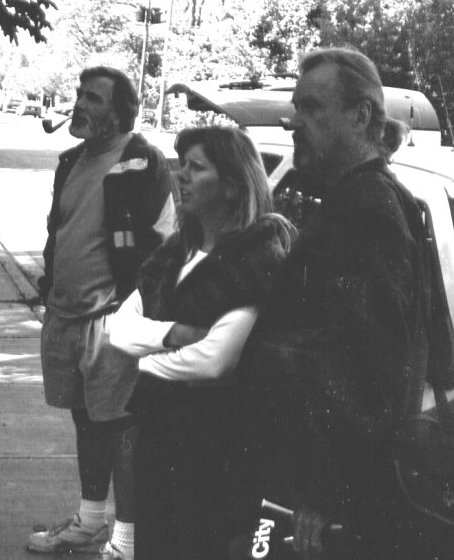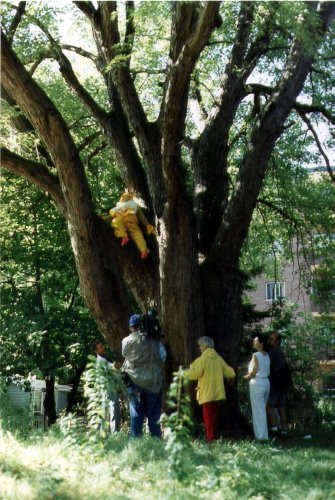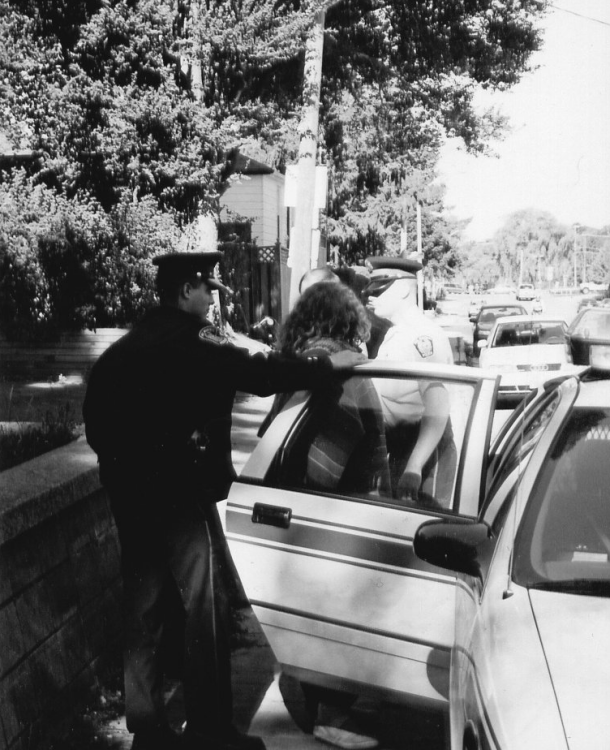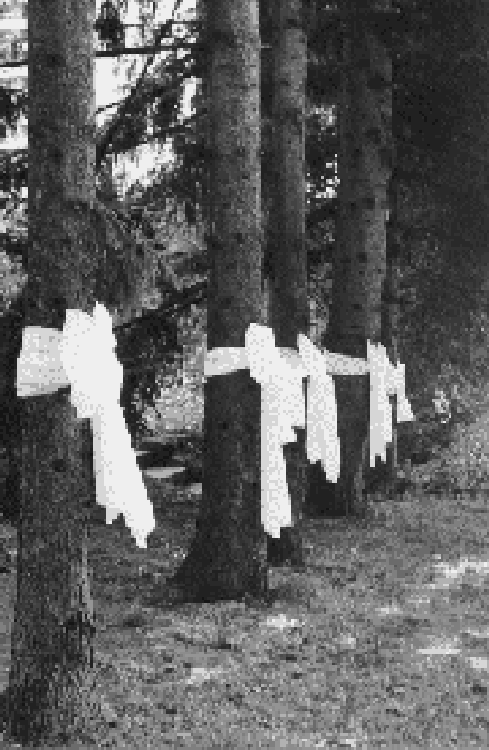Scanned, recopied or Internet copy, if there are errors, please e-mail me with corrections:
Opening comments:
One of Laurie Kallis media articles - she goes on to hang me.
Added picture Bob Hunter looks on as the trees are cut in 1998, after Laurie was arrested;

More about Bob Hunter and that day in 1998 here.
By Heather Saunders is a former director of White Water Gallery in North Bay. She is presently completing a Masters of Library and Information Studies at the University of Toronto, after which she hopes to be an art librarian. She is currently the associate publisher of FUSE magazine.
Fall/Winter 2006 - Women & Environments - By Heather Saunders - www.weimag.com
Coping With and Preventing Environmental Loss Through Art
A Tale of Two Cities
Although they have never met, Toronto's Laurie Kallis and Liz Lott, from North Bay in Ontario, have a lot in common: both are single mothers, self-proclaimed feminists, and activist artists. Kallis became an environmental artist activist as an immediate response to negative environmental change in her then-neighbourhood of Port Credit, Ontario. Lott, meanwhile, developed her environmental art activism as a deliberate plea for positive environmental change in North Bay, Ontario.
In 1998, when Kallis began using a barn as a studio, she had no idea that her canvases would be co-opted for makeshift protest signs only a short time later. The rented property, which also boasted a heritage house and trees that Kallis describes as "unusually large for Mississauga", was slated for townhouse development. History seemed doomed to repeat itself -- when the Loyalists settled on the land of the Mississaugas, they burned trees up to 20 feet in diameter for farmland. Kallis laments, "The contemporary developers investing in the Port Credit area retained the same animosity towards existing trees."
Kallis and her then-husband, Ed Troscianczuk, decided to take action when the developer announced that the trees would be felled, but they were unable to cease construction. After the first tree was taken down, they blocked Mississauga Road with two cars to get the attention of police and stall the cutting. As word spread, people expressed dismay that there was no by-law on tree-cutting. Weekly community garage sales, a straw- berry social and a music festival brought more and more people to see the trees.
When a cutting at a neighbour's property was announced, Kallis said, "We have to get more extreme for a better news story. "Wearing a costume based on the Dr. Seuss character, Lorax, who speaks for the trees, she perched in a 250-year-old tree for over 24 hours. A news anchor joined Kallis in the tree, as did firefighters and police officers who tried to coerce her to come down - courteously, she emphasizes, as her children were looking on from below. Fortunately, she had attended an Earthroots session on civil disobedience training the week before, so she knew how to speak in media-appropriate sound bytes and also how to avoid criminal charges. When she returned to solid ground, she was charged with trespassing and resisting arrest. Three trees were immediately cut.

In the aftermath, Kallis assumed an anonymous role very different from her former media-intense one. Working overnight, she and her family tied white ribbons around countless trees along Mississauga Road as part of a sculptural installation. A video documents the haunting image of a ribbon flapping in the breeze. Fellow activists followed suit, sporadically adorning trees throughout the city. Taking the time to wrap one's arms around tree after tree was an intimate process, Kallis reflects, and it captured the interest of the community. Kallis describes her art as "an appeal to the intellect through the senses that does not raise the defenses of the observer."

In a race against time, Kallis became a voice not just for the trees, but also for the community. In contemplating the process of the action, Kallis emphasizes that, "these issues were about life, [the] future life on this planet, and the health and happiness of our community. We did not approach these issues as abstract, theoretical arguments." Hitting the issues head-on brought tangible results: on June 14,2000, Mississauga City Council approved and passed a tree protection by-law.
Kallis has become much more community-based as a result of this experience. The environment is no longer merely a concept of "wild" nature. She is drawn to the concept of the environment as a base on which communities develop.
Artist Lott also strives for more community-based activism by opening people's minds, rather than prescribing a specific ideology. She lives in North Bay, a city with a population of 56,000, approximately 330 kilometres from the urban centre of Toronto. Many artists live in the area, inspired by the rugged landscape of the Canadian Shield, as well as the beauty of Lake Nipissing, the fourth-largest inland lake in Ontario.
Lott feels that, in North Bay, people take the natural landscape for granted. "Only after development do people seem to express regret," she says. For example, the old railroad tracks and their elevated support system have both been removed, killing milkweed, an important food source for monarch butterflies. This causes residents to lament, "If only we had made them into walking trails," While the city is surrounded by wilderness, Lott is surprised by the lack of trees in the city proper. There is, she says, "not enough shade, not enough mature trees."
When, in 2005, a photography festival was announced in North Bay, she proposed a body of work that would combine painting and photography. Lott had been experimenting with remaking the urban landscape on giclee prints on canvas: by painting on top of familiar scenes, a parking lot transforms into a park with trees, and the main street becomes pedestrian-only, with trees lining its centre. She describes the process of painting fictitious scenes fuelled by both hope and cynicism as cathartic.
Lott says, "The audience of my images plays a major role." She recounts that, while she was painting outside, "I sat on the sidewalk and every person who walked by said, 'That's a great idea. You should put that in City Hall’" Some of the "images have a cautionary theme, like flooding. These have a new layer of meaning after a severe storm hit North Bay in the summer of 2006, causing fatalities and incredible damage. Lott hopes that darker images will jolt people into environmental awareness. At the same time, she prefers images that reveal green potential. "There's not enough hope out there," she says. "It could be our ultimate downfall."
Lott's ability to envision potential for the future can be traced to a three-month stay in Indonesia with Canada World Youth. The pervasiveness of animism (the close connection to spirits and the earth) changed her way of thinking. She now sees trees as having symbolic value, important to our emotional wellbeing. Her connection to trees. increased when she apprenticed with esteemed Canadian landscape painter Lawrence Nickle, who introduced her to plein air painting.
The work of Kallis and Lott is responsive. For Kallis, it's a response to an unexpected public battle over rapid environmental destruction. For Lott, it's a response to slower environmental destruction, also situated in a public forum. As they continue to promote environmental awareness through their art, both Kallis and Lott find strength in womanhood — Kallis says her rallying of families is "an approach that I attribute to my being a woman and a mother," while Lott says, "The future becomes much more of a gigantic reality when you give birth to and raise your own child." These women artists have put their cities under the microscope, prompting viewers to explore their own values for the sake of their community.
Home Page - Main Table of Contents - Back up a page - Back to Top